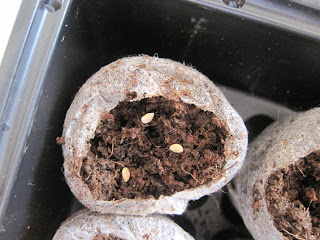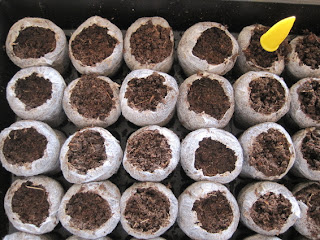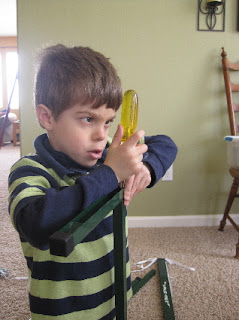Ah, the romance of seed starting.
That idyllic union of tiny-packet-of-life and moist-brown-planting-medium.
But multiply those little organic oreos by 72, and you have a migraine in the making.
Yes, those cute little dried peat hockey pucks -- that expand with water to make a fluffy seed bed-- were the bane of my existence for an entire afternoon.
Everything started out just fine. I had my 72 pellets snuggled in their tray, I had my pitcher of water, and I started to pour.
No problem. Within seconds they started to expand before my eyes, which was oddly mesmerizing.
I don’t know how to explain what happened next. I was like a three-year-old squeezing a bottle of glue. I just couldn’t stop. Even when they began to get really fluffy like this:
I thought, just a little more water couldn’t hurt (‘cause maybe they’d get even Bigger!!). A person who pays attention to detail, a person who plans ahead, would have noticed the instructions on the package that read “add approximately 10 ½ cups to expand the whole package.”
Too late. By the time I was done with my giant blue pitcher, my soil looked less like a moist planting medium, and more like Hungarian goulash.
Despite evidence to the contrary, I’m actually a good enough gardener to know that this is not a happy place for a seed. Glistening is not good. I learned this lesson the painful way, which you can read a bit about here.
Now I was faced with a dilemma: I could wait hours, probably many hours, for these pellets to dry a bit. Or I could squeeze them out into the sink, one by one, like the sopping little sponges they were. Since I’m as lacking in patience as I am in foresight, you can probably guess what I did next.
Squeeze away I did. And, I did it Seventy-two times. Seventy-two times. It took me half an hour. It’s a good thing I don’t have arthritis.
The pellets looked so much better afterward.
But the kitchen sink didn’t.
The sight of it would have left my husband imploring: why do we have a utility sink in the laundry room if not for the squeezing of dirty soil pellets? I hear you, sweetie, but the lighting in the laundry room is not conducive to taking nice photos. And look! Clean up was but the work of a moment:
‘Course the other side of the sink was a different story….
But back to seed starting.
The next step was to fluff the peat to make some nice healthy air pockets on the soil for our seeds.
Readers who know me are no doubt making a mental note: Never use the small forks at the Mills’ house.
Once my pellets were properly squeezed and fluffed,
I thought I was home free! Now I could start the fun part: planting my carefully selected seeds!
So, to solve the problem of remembering which seeds were planted where, I had already drawn up a grid with 72 squares and an accompanying legend.
My list of prospects included tomato, sweet pea, chives, sunflower, hollyhocks, daisy, dill, lettuce, poppies, cilantro and a few others.
A thing of beauty, right? And here I was a few paragraphs back complaining that I don’t plan ahead. I mean, this grid should have gotten me some major points for foresight. It should have seen me through my planting process with ease.
…and pressed them into the soil. Following my grid, I did the same with the pellet directly underneath the first one, since I planned to proceed in vertical columns. Next, it was time for sweet peas. Sweet peas? Where were my sweet peas? I couldn’t find those seeds anywhere. A quick glance around my kitchen reminded me that I’d left them to soak in glasses the night before, along with Cardinal Climber vine and Morning Glory.
See that? More points for Bel in the planning and foresight department! Certain larger, harder seeds need to be soaked ahead of sowing (it always tells you which on the packets) and sweet peas are among them. Now those seeds were swollen and ready to go.
Now, maybe you are a visually gifted person who can glance away from a grid of 72 brown circles, perform a separate task (in my case pick up more seeds), and look back to find EXACTLY where you left off, but I couldn’t do it. My attention deficit issues leave me completely unequipped for the task. So after digging up the sweet pea seeds, planting new tomato seeds (since I didn’t know how badly I’d disturbed my original tomato seeds) I came up with a solution:
(No small forks at the Mills’ House, no corn on the cob).
I placed the corn-on-the-cob holder in the pellet just underneath the one I was currently planting. Again, since I was proceeding from top to bottom in vertical columns, I knew when I looked away to grab more seeds, the corn holder would tell me in which pellet to put those seeds. Then I’d move the mini corn down, and so on, and so forth.
Here I was at the top of column five from the left, and when I looked back at my planting grid and realized I was supposed to be at the top of column six.
I'D SKIPPED AN ENTIRE COLUMN!
AYGGGODDSHYAMOTHFRACK! AGH! It took me a long, long time staring at my genius grid (and digging up a few choice seeds) to figure out which column I’d skipped.
And I was no longer having fun with this seed sowing business. To say I was yearning for the days when I planted 10 or 15 peat pots and called it a day would be an obscene understatement. The groaning was starting in earnest now, as well as a variety of frantic thoughts: “Crap! I have to pick up the boys up from school in an hour!” and “What the hell am I going to make for dinner?” and, of course “Whose lousy idea was it to plant 72 pellets and write a blog post about it?”
Next year, friends, we are going to do this differently. Forget the genius grid. I think the only way to plant 72 pellets (and please, please leave me helpful comments if you know better) is to put color coded toothpicks in each one as you go. And no grid. Because if there is no grid, then there is none of this skipping of columns business. And no tedious editing of the grid to avoid drawing up a brand new one:
Here I am spritzing the finished pellets. You love the green spritzer, right?

I love the green spritzer. I do. In fact, it almost brought back the romance. But not quite.











































